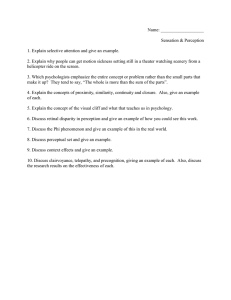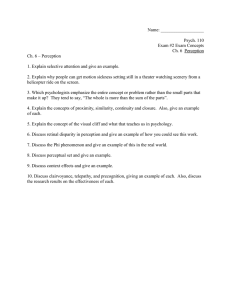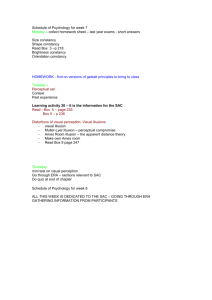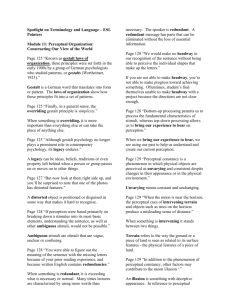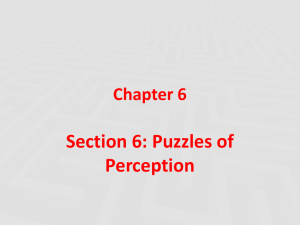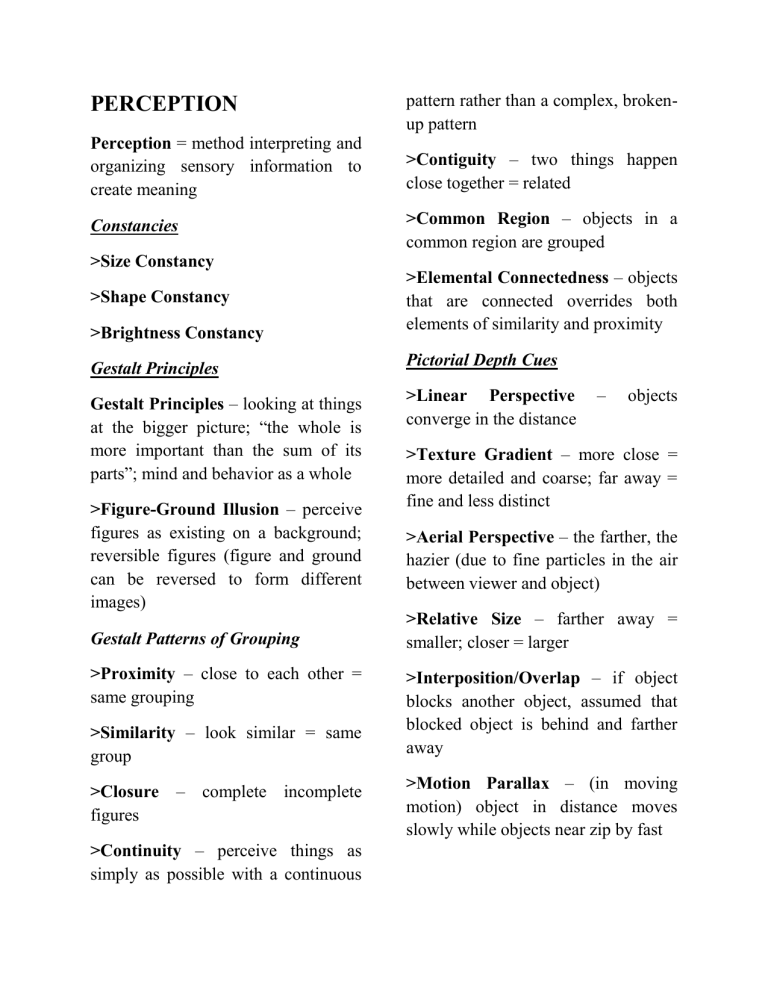
PERCEPTION pattern rather than a complex, brokenup pattern Perception = method interpreting and organizing sensory information to create meaning >Contiguity – two things happen close together = related Constancies >Common Region – objects in a common region are grouped >Size Constancy >Shape Constancy >Brightness Constancy >Elemental Connectedness – objects that are connected overrides both elements of similarity and proximity Gestalt Principles Pictorial Depth Cues Gestalt Principles – looking at things at the bigger picture; “the whole is more important than the sum of its parts”; mind and behavior as a whole >Linear Perspective converge in the distance >Figure-Ground Illusion – perceive figures as existing on a background; reversible figures (figure and ground can be reversed to form different images) Gestalt Patterns of Grouping >Proximity – close to each other = same grouping >Similarity – look similar = same group >Closure – complete incomplete figures >Continuity – perceive things as simply as possible with a continuous – objects >Texture Gradient – more close = more detailed and coarse; far away = fine and less distinct >Aerial Perspective – the farther, the hazier (due to fine particles in the air between viewer and object) >Relative Size – farther away = smaller; closer = larger >Interposition/Overlap – if object blocks another object, assumed that blocked object is behind and farther away >Motion Parallax – (in moving motion) object in distance moves slowly while objects near zip by fast when in the sky, due to the presence of other objects to compare it with Binocular Depth Cues >Convergence – involves rotation/muscles of eyes; far objects = less convergence; near objects = more convergence >Binocular disparity – eyes see a slightly different image due to being slightly several centimeters apart Perceptual Illusions Hallucination – deception stimulus is not present yet Illusion – present stimuli that deceives the eye; what is seen does not = reality >Hermann Grid – matrix of black squares seemingly creating black circles in between; opponent-process theory >Muller-Lyer Illusion – two lines, one appearing longer than the other, but really just are same length >Ebbinghaus Illusion – surrounded by bigger things can make thing smaller, surrounding smaller things can make thing in middle bigger >Moon Illusion – the moon seems larger in the horizon compared to >Perceived Motion (or apparent movement) – still objects seem moving >Autokinetic Effect – perceived motion of a single, still object (mostly light) due to fatigue in the eyes causing slight eye movement >Stroboscopic Motion – still objects in different locations, but due to rapid motion, they are seen as they are moving >Phi phenomenon – motion created by lights flashing in sequence Perceptual Expentancy >Ames Room Illusion – influenced by past experiences; viewer perceives the room as a rectangle, but is actually a trapezoid with angled walls and floor >Top-Down Processing & BottomUp Processing i.e. Devil’s Trident – three prongs cannot be real as drawn Subliminal Perception Subliminal perception (Sub-ception) – respond to stimuli that are below our level of awareness -research shows that the effects only occur in controlled lab studies Extra Sensory Perception Extra Sensory Perception (ESP) – occurs independently of the known sensory processes (i.e. telepathy, clairvoyance, precognition) >Clairvoyance – awareness of an unknown object or event >Precognition – foreknowledge of future events >Telekinesis – mental movement or motion of solid matter due to direct influence of mind >Telepathy – communication through means other than senses’ knowledge of someone else’s feelings or thoughts
